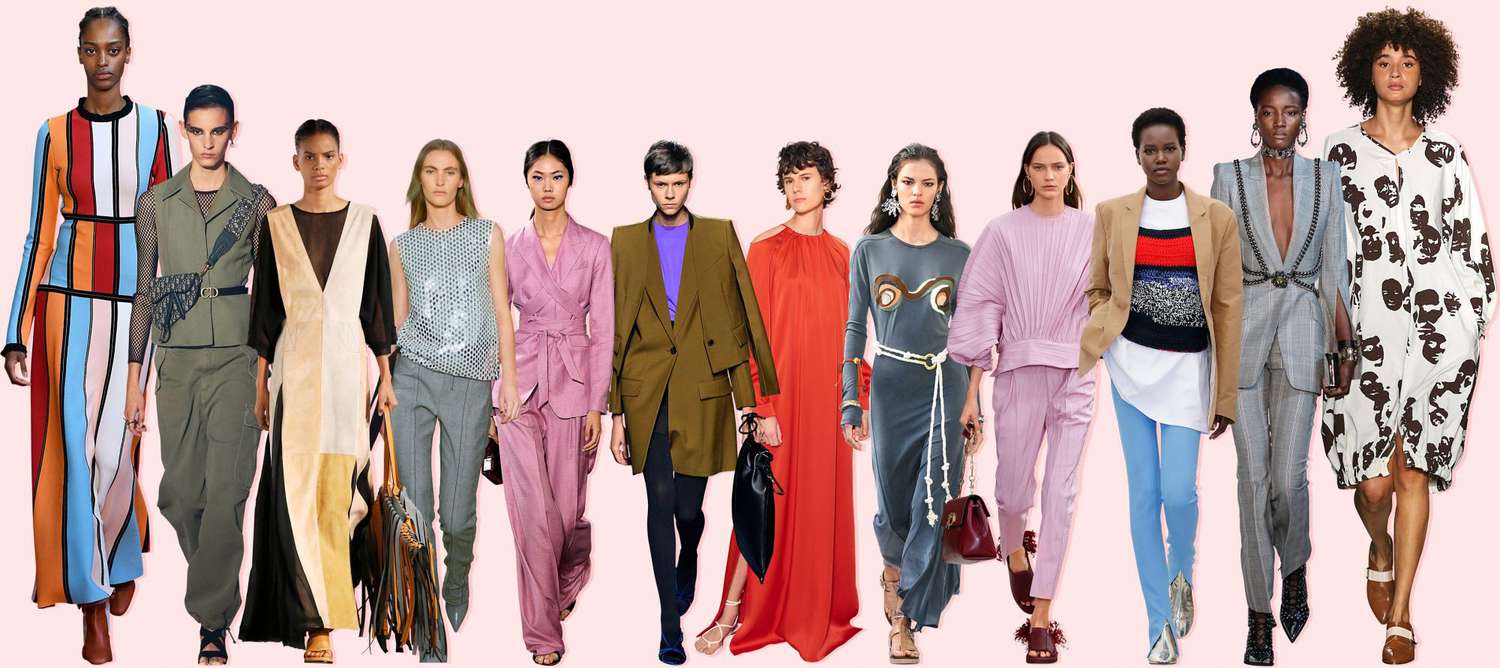Branded Clothing Essentials: Understanding the Fabric Behind the Fashion
Branded Clothing Essentials: Understanding the Fabric Behind the Fashion
Blog Article
The Importance of Sustainable Clothes: Just How It Influences the Atmosphere and Your Closet
Lasting clothes is significantly recognized for its vital duty in decreasing the ecological effect of the quick apparel industry. By concentrating on eco-friendly materials and ethical production methods, it deals with pushing environmental problems. This shift not just benefits the earth yet likewise affects customer choices, resulting in a more thoughtful approach to wardrobe administration. Understanding these characteristics increases vital concerns regarding fashion's future and individual obligation fit it.
The Ecological Footprint of Fast Fashion

Benefits of Sustainable Products
Lasting materials provide considerable advantages, specifically with eco-friendly textile choices that decrease environmental injury. These products additionally show sturdiness and long life, lowering the requirement for frequent replacements. Consequently, they add to a much more sustainable fashion business and advertise responsible customer actions.
Eco-Friendly Material Choices
While the fashion business has long been linked with fast trends and ecological damage, the rise of environmentally friendly material selections offers a transformative possibility. Lasting materials such as organic cotton, hemp, and Tencel have actually obtained appeal because of their lower eco-friendly effect. These fabrics are typically produced without unsafe pesticides and call for less water, lowering their carbon impact - Branded Clothing. In addition, many eco-friendly materials are eco-friendly, contributing to a round economy by lessening waste. Picking sustainable products not just supports eco responsible techniques but likewise advertises healthier ecological communities. As consumers become a lot more knowledgeable about their purchasing power, the demand for green fabrics motivates brand names to introduce and take on even more lasting production methods, inevitably benefiting the world and future generations
Longevity and Long Life Benefits
Lots of consumers are progressively recognizing the longevity and durability benefits of sustainable products in their clothes selections. Unlike traditional fabrics, lasting materials such as natural cotton, hemp, and recycled polyester are engineered to withstand damage, resulting in garments that last longer. This minimized regularity of substitute not just conserves consumers money over time but additionally diminishes waste created by quick style. Furthermore, sustainable apparel typically uses environmentally friendly production methods that enhance textile toughness, adding to a reduction in the general carbon footprint. By investing in durable clothing, customers can grow a much more sustainable wardrobe while taking pleasure in high-quality items that preserve their aesthetic and functionality with time. As a result, longevity and long life stand as essential benefits of selecting sustainable materials.
Lowering Waste Through Sustainable Practices
Decreasing waste in the fashion business can be attained with innovative methods such as upcycling and repurposing products. Additionally, embracing minimalist wardrobe strategies urges consumers to focus on top quality over quantity, inevitably reducing clothing intake. Together, these strategies contribute greatly to a much more lasting clothing design.
Upcycling and Repurposing Products
Upcycling and repurposing materials have become innovative techniques in the fashion business, changing discarded textiles into beneficial new items. This method not only minimizes waste yet additionally urges creative thinking and originality in garments style. By taking old garments and materials, designers can develop distinct pieces that show personal style while lowering the need for new resources. Additionally, upcycling commonly requires less energy and water compared to traditional manufacturing procedures, significantly reducing the ecological impact of fashion. As consumers become much more conscious of sustainability, the appeal of upcycled apparel proceeds to rise, promoting a circular economy. Eventually, these techniques add to a more sustainable future, where fashion prioritizes environmental wellness over fast production and usage.

Minimal Closet Strategies
As individuals progressively seek to lessen their ecological effect, embracing minimalist wardrobe strategies has gained traction as an effective strategy to lasting fashion. These strategies stress top quality over amount, encouraging consumers to curate a smaller collection of flexible, durable clothing. By concentrating on classic pieces that can be mixed and matched, people can minimize the regularity of acquisitions and eventually decrease waste.Additionally, minimalism advertises mindful consumption, prompting buyers to show on the environmental and ethical implications of their choices. This strategy not only fosters an extra lasting way of living however likewise simplifies everyday decision-making concerning clothes. As people welcome minimal principles, they add to a fashion society that values sustainability and accountable consumerism, eventually causing a more eco-conscious culture.
The Function of Ethical Labor in Lasting Fashion
While numerous consumers are significantly aware of the ecological consequences of their apparel options, the value of honest labor techniques in sustainable style can not be neglected. Moral labor encompasses fair wages, risk-free working problems, and respect for employees' rights, developing the foundation of responsible fashion manufacturing. Brand names that prioritize honest labor not only boost neighborhoods yet also set a criterion for accountability in the industry.Moreover, the assimilation of moral methods cultivates transparency, allowing customers to make informed selections about their acquisitions. This practice contrasts dramatically with rapid fashion's exploitative labor designs, which frequently focus on revenue over people. By sustaining companies dedicated to honest labor, customers contribute to a system that values human dignity along with environmental sustainability. As a result, moral labor is not merely an add-on; it is necessary to the wider objective of lasting style, ensuring that the quest for eco-friendliness does not come at the cost of civils rights.
The Influence of Lasting Garments on Carbon Emissions
Lasting apparel has the possible to substantially reduce carbon emissions related to the fashion business. Conventional garment production adds significantly to greenhouse gas emissions, largely as a result of energy-intensive manufacturing processes and the usage of non-renewable resources. In comparison, sustainable style concentrates on environment-friendly materials, such as natural cotton or recycled fibers, which typically need less power to produce.Moreover, sustainable brand names have a tendency to adopt extra effective manufacturing techniques, decreasing waste and decreasing total discharges. By focusing on resilience and classic layout, sustainable clothing motivates customers to acquire much less often, more lowering the carbon footprint related to overconsumption.Additionally, several sustainable brands are devoted to transparency in their supply chains, making it possible for consumers to make educated options that straighten with their values. Ultimately, changing towards sustainable apparel can result in a considerable reduction in carbon exhausts, adding to a healthier earth and an extra lasting future for the style sector.
Sustaining Regional Economic Situations With Sustainable Options
The change towards sustainable clothes not just addresses environmental concerns however likewise substantially advantages this contact form local economic climates. By selecting lasting style, consumers typically sustain tiny businesses and regional craftsmens, enhancing community durability. These ventures typically operate a smaller scale, focusing on workmanship and moral practices over mass production.Investing in locally made sustainable clothing fosters task development and promotes financial development within areas. As customers come to be a lot see this here more aware of the environmental effect of their purchases, they progressively seek products that mirror their worths. This need motivates regional producers to adopt lasting techniques, contributing to a circular economy.Moreover, sustaining regional organizations decreases transportation exhausts, lining up with eco-conscious consumer actions. The interconnectedness of sustainable clothing and neighborhood economic situations emphasizes the crucial duty that specific options play in promoting both economic and environmental health. By cultivating these regional connections, areas can flourish while also functioning towards a more lasting future.
Transforming Your Closet: Tips for a Lasting Wardrobe
As people seek to decrease their ecological effect, transforming a storage room into a lasting closet comes to be an important step. One reliable technique is to assess existing clothing, maintaining just products that are used regularly and that align with sustainability objectives. Prioritizing quality over quantity is essential; purchasing sturdy items from green brands can substantially minimize waste.Additionally, including second-hand products can revive a wardrobe while minimizing environmental damages. Organizing apparel swaps with friends or giving away extra things can better promote sustainability.When shopping, individuals ought to look for products that are organic, recycled, or eco-friendly, and stay clear of fast fashion sellers - Branded Clothing. Exercising conscious intake by attentively taking into consideration each purchase can contribute to an extra sustainable lifestyle. By executing these pointers, one can create a closet that mirrors individual design while sustaining environmental stewardship
Frequently Asked Questions
How Can I Identify Sustainable Garments Brands?
To determine sustainable clothes brands, one ought to research products utilized, look for certifications like Fair Trade, and examine the brand name's openness regarding their production processes, labor practices, and ecological effect, making certain moral and green methods are prioritized.
What Are the Costs Related To Lasting Fashion?
The costs linked with sustainable fashion can differ significantly. Higher manufacturing costs, ethical sourcing, and environmentally friendly materials usually bring about raised list prices, which might prevent some consumers while appealing to environmentally mindful buyers.
Can Sustainable Clothing Be Stylish and stylish?
Lasting garments can certainly be stylish and trendy. Designers increasingly focus on innovative materials and honest production approaches, confirming that fashion and sustainability can coexist. Customers currently have varied click to investigate alternatives that mix visual appeals with environmental awareness.
Just How Does Laundering Clothes Affect Their Sustainability?
Cleaning garments substantially influences sustainability by consuming water and energy, adding to contamination, and causing microplastic launch. Constant washing can degrade textiles, shortening their life-span and boosting the need for replacements, eventually aggravating ecological problems.
What Is the Life Expectancy of Lasting Clothing Compared to Fast Fashion?
The life expectancy of sustainable clothes typically surpasses that of rapid fashion items, often enduring a number of years due to top quality materials and workmanship. In comparison, fast fashion garments might break down quickly, demanding even more constant replacements. Lasting clothes is progressively identified for its vital role in reducing the ecological effect of the quick fashion market. While many customers are progressively conscious of the environmental consequences of their apparel options, the significance of ethical labor methods in lasting style can not be overlooked. Branded Clothing. Sustainable garments has the prospective to greatly decrease carbon discharges associated with the style market. In comparison, sustainable fashion focuses on environment-friendly products, such as organic cotton or recycled fibers, which often need less power to produce.Moreover, sustainable brands often tend to take on more efficient manufacturing techniques, decreasing waste and decreasing general emissions. By prioritizing durability and timeless design, sustainable clothes motivates consumers to acquire less frequently, further reducing the carbon impact linked with overconsumption.Additionally, many lasting brand names are committed to transparency in their supply chains, making it possible for customers to make informed options that align with their worths
Report this page